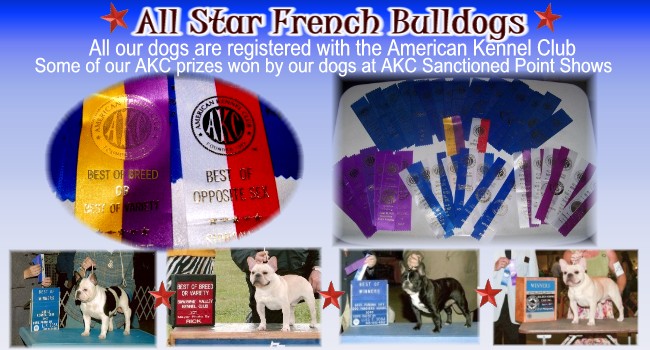|
-
AKC
French Bulldog Standard

•Non-Sporting Group; AKC recognized in 1898
•Must weigh 28 pounds or less.
•Companion.
American Kennel Club : http://www.akc.org/breeds/french_bulldog/index.cfm
--------------------------------------------------------------------------------
French Bulldog Breed Standard
Non-Sporting Group
The French Bulldog has the appearance of an active,
intelligent, muscular dog of heavy bone, smooth coat, compactly built,
and of medium or small structure. Expression alert, curious, and interested.
Any alteration other than removal of dewclaws is considered mutilation
and is a disqualification.
Proportion and Symmetry--All points are well distributed
and bear good relation one to the other; no feature being in such prominence
from either excess or lack of quality that the animal appears poorly proportioned.
Influence of Sex--In comparing specimens of different
sex, due allowance is to be made in favor of bitches, which do not bear
the characteristics of the breed to the same marked degree as do the dogs.
-
Size, Proportion, Substance
Weight not to exceed 28 pounds; over 28 pounds is
a disqualification. Proportion--Distance from withers to ground in good
relation to distance from withers to onset of tail, so that animal appears
compact, well balanced and in good proportion. Substance--Muscular, heavy
bone.
Head large and square. Eyes dark in color, wide apart,
set low down in the skull, as far from the ears as possible, round in form,
of moderate size, neither sunken nor bulging. In lighter colored dogs,
lighter colored eyes are acceptable. No haw and no white of the eye showing
when looking forward. Ears Known as the bat ear, broad at the base, elongated,
with round top, set high on the head but not too close together, and carried
erect with the orifice to the front. The leather of the ear fine and soft.
Other than bat ears is a disqualification. The top of the skull flat between
the ears; the forehead is not flat but slightly rounded. The muzzle broad,
deep and well laid back; the muscles of the cheeks well developed. The
stop well defined, causing a hollow groove between the eyes with heavy
wrinkles forming a soft roll over the extremely short nose; nostrils broad
with a well defined line between them. Nose black. Nose other than black
is a disqualification, except in the case of the lighter colored dogs,
where a lighter colored nose is acceptable but not desirable. Flews black,
thick and broad, hanging over the lower jaw at the sides, meeting the underlip
in front and covering the teeth, which are not seen when the mouth is closed.
The underjaw is deep, square, broad, undershot and well turned up.
The neck is thick and well arched with loose skin
at the throat. The back is a roach back with a slight fall close behind
the shoulders; strong and short, broad at the shoulders and narrowing at
the loins. The body is short and well rounded. The chest is broad, deep,
and full; well ribbed with the belly tucked up. The tail is either straight
or screwed (but not curly), short, hung low, thick root and fine tip; carried
low in repose.
Forelegs are short, stout, straight, muscular and
set wide apart. Dewclaws may be removed. Feet are moderate in size, compact
and firmly set. Toes compact, well split up, with high knuckles and short
stubby nails.
Hind legs are strong and muscular, longer than the
forelegs, so as to elevate the loins above the shoulders. Hocks well let
down. Feet are moderate in size, compact and firmly set. Toes compact,
well split up, with high knuckles and short stubby nails; hind feet slightly
longer than forefeet.
Coat is moderately fine, brilliant, short and smooth.
Skin is soft and loose, especially at the head and shoulders, forming wrinkles.
Acceptable colors - All brindle, fawn, white, brindle
and white, and any color except those which constitute disqualification.
All colors are acceptable with the exception of solid black, mouse, liver,
black and tan, black and white, and white with black, which are disqualifications.
Black means black without a trace of brindle.
Correct gait is double tracking with reach and drive;
the action is unrestrained, free and vigorous.
Well behaved, adaptable, and comfortable companions
with an affectionate nature and even disposition; generally active, alert,
and playful, but not unduly boisterous.
Any alteration other than removal of dewclaws.
Over 28 pounds in weight.
Other than bat ears.
Nose other than black, except in the case of
lighter colored dogs, where a lighter colored nose is acceptable.
Solid black, mouse, liver, black and tan, black
and white, and white with black. Black means black without a trace of brindle.
Approved June 10, 1991
Effective July 31, 1991
From this link:
http://www.akc.org/breeds/french_bulldog/index.cfm

-
French Bulldog Did You Know?
•It is fairly well established that one of the ancestors
of the French Bulldog is, not surprisingly, the English Bulldog (most likely
one of the toy variety).
•Two distinctive features of the French Bulldog
are its bat ears and half-flat, half-domed skull.
•Originally called the Boule-Dog Francais, though
the english later scoffed at the idea of calling an English dog by a French
name.
•Had it not been for the objections of American
fanciers, the bat ear of the French Bulldog would have been bred out of
the breed and replaced with a rose ear, resulting in a miniaturized version
of the English Bulldog.
•The first specialty club was the French Bulldog
Club of America, and fanciers gave a specialty show in the ballroom of
the Waldorf-Astoria in NYC in 1898, the first specialty show to be held
in such deluxe quarters. Receiving serious press coverage, French Bulldogs
were thrust into vogue, reaching a peak in 1913 with an entry of 100 at
the Westminster Kennel Club.
•While bred primarily as pets and companions,
Frenchies are remarkably intelligent and serve as good watchdogs.


|




